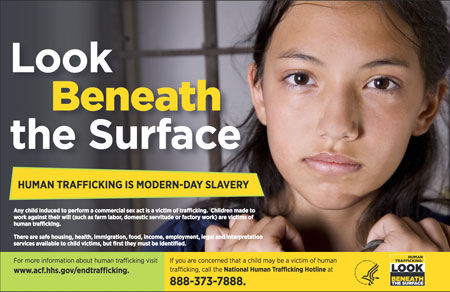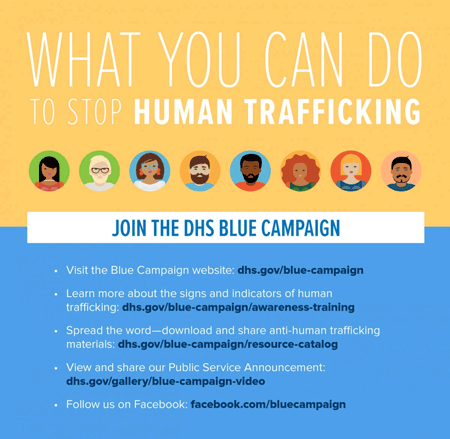Resources for Victims and Healthcare Professionals
Victims need to know about potential resources, and once they are able to escape their abusers, survivors need a great deal of support, beginning with basic needs. Nurses are one of the few professional groups that interact with victims while they are still under control of their abuser (Roe-Sepowitz et al., 2015). A proactive facility approach with a staff trained in appropriate interventions and can provide the most help to victims. The more you know, the more you may be able to help someone.
Studies estimate that between 30% and 88% of trafficked persons seek medical services at some point during their capture (Schwarz et al., 2016). When you suspect a patient may be the victim of trafficking, having staff properly trained with an assessment tool has the potential to rescue lives.
Numerous universities and community organizations have developed and begun implementing human trafficking assessment tools for their facilities. Because small community hospitals don't have the same needs or resources as large urban ones, each assessment tool needs to be customized for the organization and its local resources, breaking it down and reconstructing it to fit the needs of the community.
Organizations need to focus on a victim-centered approach. Safety and proper support can help transform the victim into a survivor. When you identify a potential victim, you may be overwhelmed with emotion, but proper training will help you to remain professional and stay focused. The first task is to keep everyone safe. If the abuser is present, take care to avoid a confrontation that could turn violent or, at the very least, result in the abuser taking the patient away.
Simply asking patients if they are trafficking victims is fruitless, especially if the abuser is present. Further, many victims do not think of themselves as victims. During the process of grooming, victims are led to believe they are making a good choice for themselves—but as time passes, they come to believe there is no way out (Egyud & Whiteman, 2016).
Did You Know. . .
Traffickers are usually very "protective" of their victims because they allow the abuser to live lavishly; traffickers can earn $150,000 to $200,000 per year with only 4 to 6 victims in captivity!
National Human Trafficking Hotline
The National Human Trafficking Hotline (NHTH)* maintains a database of service providers who deal with human trafficking throughout the United States, including private, state, and faith-based providers. The Hotline can assist victims directly or help healthcare and other facilities connect with existing resources in their area as they begin developing a response protocol for victims of human trafficking. The Hotline has a referral network for anti-trafficking organizations, legal service providers, shelters, law enforcement, and local social service agencies to assist victims of human trafficking. Facilities can also turn to the NHTH for training materials on a variety of topics related to trafficking.
*Formerly the National Human Trafficking Resource Center (NHTRC).
In addition, the Hotline offers confidential 24-hour access to anyone who wants to report tips, seek services, or just ask for help or information. Access is provided in more than two hundred languages through a tele-interpreting service. All communications with the Hotline are strictly confidential to the extent permitted by law.
If your agency has a possible trafficking victim and is unsure what to do, call the Hotline at 800 373 7888 for assistance to conduct an assessment. The Hotline provides an assessment tool on its website to assist potential victims of trafficking (see previous section).
A detailed narrated presentation about what to expect when calling the Hotline is available on the Hotline website. It explains the process followed on a Hotline call, the assistance that can be provided immediately and as follow-up, to whom information may be reported and the process by which decisions to report are made, and finally what is done with the data collected by the Hotline (NHTH, 2015).
Human Trafficking Assessment Tool for DVP
The following is from the NHTH Human Trafficking Assessment Tool for Domestic Violence Programs and can be used to evaluate a potential trafficking situation and determine danger and when to contact the National Human Trafficking Hotline (NHTH, 2011).
Trafficking Indicators
Sex Trafficking may include persons who are:
- Forced by a partner or family member to provide sexual favors or commercial sex to others through informal arrangements, online advertisements, escort services and/or street prostitution.
- In the commercial sex industry and have a controller (boyfriend, pimp, manager, or "daddy") or mentions having to meet a nightly monetary quota.
- Under 18 years of age and providing commercial sex acts.
- Exhibit poor health and/or have multiple untreated sexually transmitted diseases/infections.
- Terminated multiple pregnancies over a short period of time. If pregnant, hesitates to answer who the father may be or seems unsure of who the father is.
- Exhibit signs of branding such as tattoos with the controller's name, and/or burn marks.
Labor Trafficking may include persons who (are):
- Forced by a partner/family member to work inside the home in a situation of domestic servitude or outside the home and experiences wage confiscation.
- Unable to access earnings and is not allowed access to any family finances.
- Work excessively long hours outside of the home or within the home for little or no compensation.
- Not allowed to take breaks from domestic work and not allowed to eat unless permitted by the controller.
- Owe a debt to a partner/family member that they are unable to pay off.
- Have unexplained injuries or signs of untreated illness or disease.
- Living in a location where they are monitored or confined by the partner/family
First Response
Discuss involving law enforcement or calling NHTH, then notify. Be vigilant of immediate environment: who is watching, listening, calling, etc. You can ask the hotline to assist in assessing level of danger.
Assessment of Potential Danger
Consider asking the potential victim the following questions:
- Does someone control/supervise, or look over what you do?
- Is your communication (calls, emails, conversations) ever restricted or monitored?
- Do you have access to all your identification/personal documents?
- What would happen if you left this person/situation or if you didn't do what this person told you to do?
- How much time can you spend at the current location?
- Do you believe that you or a family member is in danger?
- Do you want assistance in leaving your situation?
Perceived Danger
The Hotline can assist in determining the next steps. You may need to involve law enforcement for victim safety. The Hotline can assist in determining appropriate, sensitive law enforcement contacts.
Call the National Human Trafficking Hotline: 888 373 7888, which is available 24/7 and has access to 170 languages. Ask for assistance with assessment questions, resources, and next steps. Be prepared to indicate which questions you used from the steps above. The Hotline can help determine appropriate next assessment of potential danger.
No Perceived Danger
Consider asking the potential victim the following questions:
- Have you ever been forced to do work you didn't want to do?
- Have you ever been forced to have sex to pay off a debt?
- Does anyone hold your identity documents (driver's license/passport) for you? Why?
- Have physical abuse or threats from your boyfriend/controller made you fearful to leave your situation?
- Has anyone lied to you about the type of work you would be doing?
- Were you ever threatened with deportation or jail if you tried to leave your situation?
Then call the Hotline (888 373 7888) or text HELP or INFO to BeFree (233733).
Health and Human Services (HHS)
Another valuable resource is the U.S. Department of Health and Human Services, Office on Trafficking in Persons (OTIP). The OTIP website lists multiple resources, including legal rights information.
The OTIP campaign "Look Beneath the Surface" emphasizes the idea that most people would not recognize a trafficking victim because they may not look any different than anyone else they see every day (OTIP, 2019).

Source: DHS, 2017.
The OTIP operates a number of programs and services including the National Human Trafficking Training and Technical Assistance Center (NHTTAC), which delivers training and technical assistance to enhance the public health response to human trafficking by reducing the risk of trafficking, increasing victim identification, improving access to trauma-informed services, and strengthening outcomes for trafficking survivors. Services include the SOAR to Health and Wellness Training for healthcare and social service providers on how to identify, treat, and respond appropriately to human trafficking and professional development opportunities for survivors. NHTTAC also provides support for the National Advisory Committee on the Sex Trafficking of Children and Youth in the United States (OTIP, 2019b).
Clinicians or the general public can view the NHTTAC website or contact NHTTAC by email ([email protected]) or by calling 844 648 8822. OTIP suggests that those wanting to report a tip or get connected with trafficking contacts in their area email or call the National Human Trafficking Hotline at [email protected] or 888 373 7888 (see above).
The SOAR to Health and Wellness Training program is directed at healthcare providers, social workers, and behavioral and public health professionals. After completion, you should be able to:
- Stop: Describe the scope of human trafficking in the United States.
- Observe: Recognize the verbal and non-verbal indicators of human trafficking.
- Ask: Identify and interact with individuals who have experienced trafficking using a victim-centered and trauma-informed approach.
- Respond: Respond effectively to potential human trafficking in your community by identifying needs and available resources to provide critical support and assistance.
The SOAR program uses a public health approach to build the ability of communities to identify and respond to the complex needs of victims and survivors of human trafficking. The program helps trainees to understand the root causes that make individuals, families, and communities vulnerable to trafficking.
The program's website details the program, its intended audiences, and links to SOAR online training (OTIP, 2019c).
While not yet validated, the NHTTAC has recently produced a screening toolkit for use by healthcare providers, social workers, and behavioral and public health professionals for screening adults suspected of being victims or human trafficking. The Adult Human Trafficking Screening Tool and Guide can be found on this website.
The executive summary notes that
the prevailing framework to screen for adult human trafficking has historically been rooted in a criminal justice…mostly screening for victims intersecting with law enforcement institutions. A public health approach recognizes that victims of trafficking intersect with multiple systems of care, including health and human services, educational settings, and community and faith-based organizations that can provide assistance to victims and their families. A public health approach also emphasizes screening to prevent potential trafficking victimization or re-victimization, especially for individuals who are at disproportionate risk of human trafficking. (OTIP, 2018a,b)
DHS Blue Campaign
The U.S. Department of Homeland Security offers a website resource under its Blue Campaign to work toward ending human trafficking (DHS, 2017). The website recognizes the key indicators of victims of human trafficking as the first step in identifying victims. This site contains general information for the public as well as tips and resources for contacting law enforcement and obtaining assistance if there is a suspected victim of human trafficking.
To report suspected human trafficking to Federal law enforcement [US Immigration and Customs Enforcement (ICE) Homeland Security Investigations (HIS)]: 866 347 2423
Note: There are other reporting lines that may be more appropriate and/or preferred by your facility or agency, such as the National Human Trafficking Hotline listed above.
Note: There are other reporting lines that may be more appropriate and/or preferred by your facility or agency, such as the National Human Trafficking Hotline listed above.

Source: DHS, 2017.
